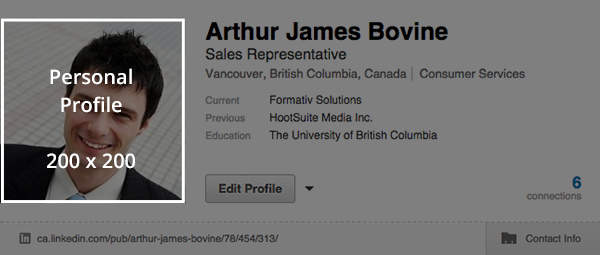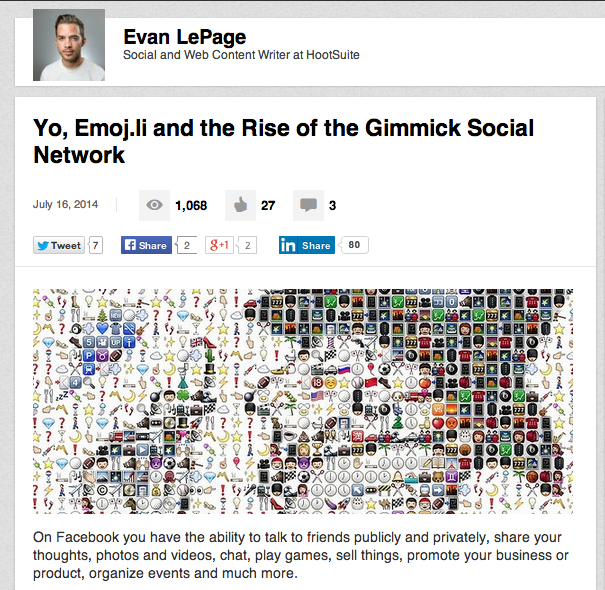Every publicly accessible social media profile you have is a professional social media profile. It doesn’t matter if you intend it to be so or not.
If this set off alarm bells, you’re far from alone. Many people neglect their personal profiles in favor of business accounts, without realizing that colleagues, clients and competitors are usually checking both.
After you soak that in, you should realize that this is actually a big opportunity for many professionals. When people visit your profile, they’re giving you another chance to impress them, to connect and build new connections and increase your professional reach. For this to happen, you need to be aware of the impression you’re creating with your personal profiles. The right impression will come when you establish a strong social media brand.
In addition to giving you more flexibility, your personal social media brand will differ from that of your business’ in several ways. We break down these differences below, and offer tips to help you strengthen your social media brand.
Separate the personal (private) from the professional (public)

Most major social networks make their business features very apparent. On Facebook, companies are required to have Pages, not Profiles. The same goes for both LinkedIn and Google+. When it comes to professional social media profiles however, the lines are far more blurred.
The first thing you need to be aware of is whether your existing profiles on each social network are public. On Twitter, your profile is default-public. Most users are aware of this. The same can be said about LinkedIn, which bills itself as a professional social network to begin with.
Perceptions differ when it comes to Facebook or Instagram. Most people have a personal Facebook profile, but very few people use it as a professional channel. And yet, many of those personal profiles are publicly accessible. Instagram is in a similar position, where the vast majority of people set their profiles to public, but only use them for personal purposes.
Your first instinct might be to restrict who can view your profiles on these social networks. You don’t want to stop having personal profiles, but silo that overly personal content to a small group of contacts. That’s generally a good idea, but restricting your social media presence too tightly can reduce the professional opportunities you can earn through these profiles. Thankfully, there are alternative options.
If you want to use Facebook as a professional network, depending on your career you may consider creating a Facebook Page for yourself. A page will become the Facebook touchpoint for clients or colleagues that are scoping you out or trying to engage with you. It also sets you apart from your business page, which is valuable for building a personal brand. You can use a Page to post professional content (without annoying your friends and family) that will help you attract and engage your target professional audience.

Your personal page, and the people who Like it, will follow you even as you change workplaces or careers. Take the example of a physiotherapist. A physiotherapist might work for a clinic with a Facebook page, and contribute to that page. So why have their own page? Well, the physiotherapist may build a strong connection with clients who then provide positive reviews on their Facebook page. Or they might engage their followers with great advice and start a conversation around physical health. If the physiotherapist were to change clinics or open their own practice, these reviews and conversations would follow them. If they only contributed to the clinic’s Facebook page, without having one of their own, all that positive information would be lost.
What about a social network like Instagram that has no specific features to distinguish regular people from businesses or professionals? First, consider what you’re posting. If you prefer that it stay private, make your account private and create a separate professional account. Upload pictures from your work environment, your meetings, your business culture, and other relevant images from your professional life. Match your username to that of your Twitter profile or Facebook page, so that clients or colleagues can easily find you.
All this to say, if social networks give you the option to create a professional profile separate from any personal profiles, do so. If you don’t have that option, seriously consider changing your permissions to keep the personal profile private. Then, think about creating a second profile and targeting the content of it towards your professional audience, so your don’t miss out on any opportunities.
Social media branding tip: Google yourself. It’s the easiest way to find out which of your profiles need work. If any of your social profiles rank at the top, or even within the first few Google search results, you’re probably doing a more than adequate job with social media branding on those networks (or you have a very unique name, which always helps. Sorry John Smith.). When you have to go digging through several pages of search results, you may want to consider increase the resources you allocate to those profiles.
Create a consistent visual brand
Part of creating your social media brand will involve choosing the right images for your profile picture and cover photo.
Where your business’ profile will usually use a logo or mascot for the profile photo, your profile photo should be of you. It shouldn’t be of you in the pool, you out with friends or you on vacation; it should probably just be a professional headshot. In certain situations, people appreciate a profile photo that shows a little more personality. In general, though, a professional headshot, well-framed and well-lit, makes you easily identifiable and quickly shows clients that you take your job seriously.

The cover photo is a much better place to show your personality. Choose a cover photo that shows a different side of your work. Maybe it’s an image of your work space, a picture of you interacting with clients, a shot of your latest piece of content, or anything else that offers a visually compelling look at what you do. When people visit your profile, your cover photo is the first thing they’ll see, so take the time it requires to get it right.

Brand consistency, or ensuring that all of your profiles share the same branding, is extremely important for professionals. You want people searching for you to immediately know if they’ve come across the right person. Keeping your profile photo and cover photos consistent is an easy way to keep things familiar while encouraging your community to follow you on multiple social networks
Social media branding tip: The same principles apply to your ‘handles’ or usernames.Don’t force people to hunt for you, make it easy on them. Having different handles for Instagram, Twitter and Pinterest is a great way to lose potential followers and mentions.
Identify your brand voice
Every brand has a voice and you need to establish your own. Thankfully, building a brand voice is a lot easier for a person than for a business. Make a list of the qualities and values you hope to embody as a professional and use it to shape your existing voice for social media. Decide in advance the type of language you’ll use and how you’ll address various situations on social media. This preparation will help you maintain a consistent social media brand.
In general, social media users don’t expect a formal or serious tone. Of course it depends on the industry, but you should strive to keep things light, use humor where appropriate and show your personality.
That being said, most of your prospective clients or colleagues won’t be interested in your breakfast plans or your thoughts on American Idol. Content strategist Jay Baer explained, “When tweeting or blogging or status updating about your personal life, it should be something that actually reveals a dimension of your life, or character, or belief system.” A CEO that also competes in triathlons shouldn’t be afraid to talk about that, as it might reveal his determination, a commitment to fitness, a drive that continues outside of the business environment.
Social media branding tip: Visuals are a great way to show personality even if you want your message to remain clear. Using gifs, videos or images in a way that shows humor or personality won’t dilute the social media messaging or your content, but it will appeal to a far broader audience of social media users.
A simple social media goal: brand awareness

When a business commits itself to social media, it needs to tie its online efforts back to broader business goals. These goals might include driving website visits, signups, leads and sales, and require that content be created and shared with specific goals and tracking in mind.
When you’re building your personal social media brand, you’re not restricted by the same process. Building your brand is about building awareness about you and your skills/knowledge/career/position. In other words, your social media efforts only need to help you attract the right audience and grow your community. With no calls to action required, you’re free to instead focus on your content—which is perfect on social media, where content means everything. For an individual professional, the right solution to this problem will often be thought leadership.
Thought leadership is a buzz-wordy term to describe content that shows you to be an expert or a leader in your field. Creating thought leadership content is about answering the questions of your target audience, showing you know what you’re talking about, and providing enough value to give them a reason to follow you. Many people distinguish themselves in this way through contributed articles to major websites or publications, speaking opportunities, or even their personal blogs. Increasingly, though, social media is becoming the platform of choice for thought leadership.

LinkedIn leads the way in that regard. The LinkedIn publishing platform doesn’t even allow businesses to publish posts, which puts the onus on individuals to publish content. While many executives are still using this to push their businesses, individual professionals have distinguished themselves as thought leaders on this channel. Thought leadership content can easily be shared any social network, from infographic pin boards on Pinterest to quick tips within Instagram images. Make sure you focus your attention on pushing thought leadership content where your target audience is looking for it.
Social media branding tip: Pick a few topics that you know better than most other people, and make those the focus on your social media brand. This topics should be specific, not broad, since you want to create your niche. Thought leadership is about distinguishing yourself, so really hone in on the subjects and traits that set you apart from the pack.
In addition to thought leadership content, more and more professionals are building their social media brands by showing their leadership within social media chats and discussions. This leads us to….
Engagement over publishing

Even though content is an essential part of building your social media brand, engagement is where you should be focusing your time. Big brands often have the luxury of attracting large audiences without actually putting in the work of engaging their community. But brands that do engage with their followers really set themselves apart from the pack, and the same applies to professionals.
To build your personal social media brand, you’ll want to always be engaging with key members of your community and influencers. Find the hashtags and Twitter chats that dominate your industry and start listening in. Where a business often focuses on starting their own chat or discussion, or pushing branded content within conversations, individual professionals should instead focus on joining the conversations that are already underway. Get a sense of the tone and subject matter of these conversations. Follow the social media influencers who already have clout in these areas and see what you can learn from their social media messaging.
Once you feel comfortable, join the conversation. Take part in chats and start conversations with other participants. Engage regular users and influencers, anyone who might appreciate your professional insight. If you consistently contribute helpful insight and keep conversations going with this community, people will come to know you as a thought leader in your industry and your following will grow. This will become your social media brand.
Social media branding tip: Engagement also means acknowledging those who take the time to share your content or engage with you. You should be listening for mentions of your handle, your name or your content. Reach out to those people and thank them, follow them, or even share some of their content. If people see you as someone who actually engages social media followers, they’ll be far more willing to become one.
Ultimately, social media is about building relationships. People are far more comfortable building relationships with people than businesses. Building a strong, personal social media brand will increase your chances of building meaningful relationships that follow you throughout your career. Establish your personal brand, and become a social media leader within your organization and your industry.
Want to start building your brand? Check out our guide to setting up every social media profile.